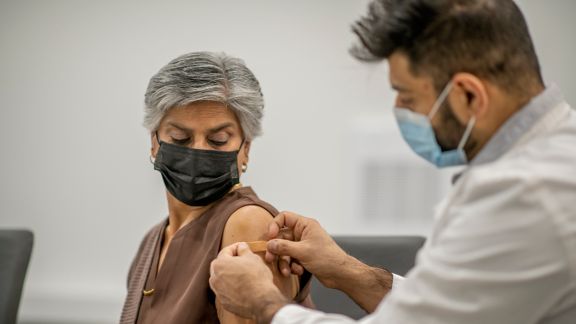Technology-Facilitated Abuse: Recognizing the Problem & Choosing a Response

Part of our Goal: Resilience collection, where NORC researchers share insights from their work in support of human resilience.
Author
Elizabeth Mumford
Senior Fellow, Public Health
April 2024
As our daily reliance on internet-connected devices increases, so does our risk of technology-facilitated abuse (TFA).
Demonstrating resilience in the face of this abuse requires recognizing that it has occurred and turning to trusted resources to manage the problem or its consequences. Professional service providers need to be prepared to serve as trusted and effective resources for those who have experienced TFA.
What Is TFA?
For starters, the term—technology-facilitated abuse—is bewildering. What forms of technology? How is this technology wielded? What constitutes abuse? And while we may all suffer from some optimism bias that “it won’t happen to me,” I will be the first to admit that I am not invulnerable. (I still answer my landline and am not a regular, savvy social media user myself.)
Cognitive interviews with young adults suggest that “cyber-abuse” or “cyber-harassment” are the more easily understood terms. But those terms may not evoke the wide range of experiences that constitute TFA, such as financial scams or control of Bluetooth-operated household thermostats or locks.
To address these gaps in the public’s—and researchers’—understanding of what constitutes TFA, some of my NORC colleagues and I, working with our partners at the Safety Net Project, surveyed a nationally representative sample of 1,215 young adults, ages 18-35, about their experience of 27 different forms of TFA (the full list is published in our paper here.)
Recognizing a TFA Problem
Surveillance, financial abuse, reputation harm, controlling behaviors—the range of abusive behaviors that humans can come up with is expanded through technology, including the potential to commit physical harm.
Our survey found that 7 in 10 young adults reported that they have experienced TFA. These experiences can be frightening, maddening, or just plain annoying, depending on the level of threat.
How does resilience come into play?
As noted in our research, individuals who experience TFA are not to blame. Experiencing harassing, aggressive, irritating TFA (the descriptor varies by person and scenario) may trigger a range of reactions. But the magic of resilience is choosing how to respond, rather than react, to an abusive situation (this one-page University of Missouri Extension flyer is a great summary).
Severity, recurrence, duration, whether the TFA is linked to real-life safety, who is perpetrating the abuse, and many other factors contribute to how someone may choose to respond. There isn’t a single right answer, but one constructive coping strategy in the face of adversity is to seek help from family, friends, or professionals.
Seeking Help
It may seem intuitive that survivors of TFA would share their worries or seek help. Family and friends may be part of initial outreach, but people experiencing TFA may also ask a range of professionals for help.
Our survey of young adults found that:
- The majority (>70 percent) who have experienced TFA do not actively seek help from professional sources.
- For those TFA survivors who do reach out, tech support (e.g., to increase security on devices) is consulted most often (30 percent), followed by criminal justice/legal assistance (20 percent), health care professionals (16 percent), and victim services (11 percent).
- The type of professional help sought varies according to the survivors’ gender identity, ethnicity or race, and age, as well as the survivor’s relationship with the perpetrator of the abuse.
The key takeaway is that effective coping strategies may differ by individual and situation. But solving a problem within the relatively new space of TFA may involve drawing on professional assistance from different experts, in addition to striving for individual resilience in the face of the abuse. Our study may be seen as a positive challenge for professionals across a variety of sectors to be ready when approached for help.
Professional and Organizational Assistance
The federal government offers an easy link to report scams perpetrated online, which is increasingly relevant as scammers target all age groups.
But many forms of abuse are not related to financial scams. The Safety Net Project has created a set of toolkits to help survivors of TFA get help. Assistance is available to address victim confidentiality, tech safety tips and documentation through apps, and related health needs. Criminal justice may be sought through law enforcement or legal aid (see also the Cyber Civil Rights Initiative for information about state laws or to connect with an attorney regarding image-based abuse).
Professionals in health care, technology services, victim services, and criminal justice must also be educated about TFA, to be prepared to support survivors—which could be any one of us—who ask for help.
Related Publications
Mumford, EA, Maitra, P, Sheridan, J, Rothman, EF, Olsen, E, & Roberts, E. (2023). Technology-facilitated abuse of young adults in the United States: A latent class analysis. Cyberpsychology: Journal of Psychosocial Research on Cyberspace, 17(3), Article 7. https://doi.org/10.5817/CP2023-3-7
Mumford, E. A., Rothman, E. F., Maitra, P., & Sheridan-Johnson, J. (2023). US young adults’ professional help-seeking in response to technology-facilitated abuse. Journal of interpersonal violence, 38(11-12), 7063-7088. https://doi.org/10.1177/08862605221140042
Citation
Mumford, E. (2024, April 11). Help-Seeking Services & Support for People Experiencing Technology-Facilitated Abuse. [Web blog post]. Goal: Resilience. Retrieved from www.norc.org.







